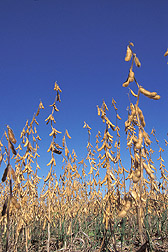This page has been archived and is being provided for reference purposes only. The page is no longer being updated, and therefore, links on the page may be invalid.
|
|
Old Asian Battle Renewed in South Dakota Soybean FieldsBy Don ComisAugust 12, 2003 The first aphid to colonize U.S. soybean plants has now spread as far west as South Dakota. Originating in Asia, the Chinese soybean aphid, Aphis glycines, was first detected in U.S. soybean fields in Wisconsin in 2000. Now the aphid is in 16 states, the latest being South Dakota, where it arrived in 2001. Agricultural Research Service plant physiologist Walter Riedell and entomologist Louis Hesler have joined forces with South Dakota State University (SDSU) graduate student Eric Beckendorf and with Michael Catangui, of the SDSU Cooperative State Extension Service. Their goal: to protect American soybeans against a foe the plants' ancestors have faced in Asia for thousands of years. Riedell and Hesler are with the ARS' Northern Grain Insects Laboratory in Brookings, S.D. This research, partly funded by the South Dakota Research and Promotion Council, is in cooperation with other ARS locations and universities throughout America's soybean belt. Riedell and Beckendorf are placing aphid-filled cages over soybean plants to determine how many aphids it takes to do serious damage at each stage of the plants' growth. From this, they will determine when farmers should spray to protect yields. Chinese soybean aphids are particularly prolific, with newborns able to bear young in just one week. This summer, Beckendorf has seen the population in one cage of aphids explode from 10 insects to 1,000 in two weeks. One question that's arisen is whether the aphid's ancient enemy, the ladybug, can keep the aphid in check. Hesler is surveying to see which species of ladybugs colonize soybeans. So far he's found that the Asian ladybug, European seven-spotted ladybug and native convergent ladybugs do. ARS is the USDA's chief scientific research agency. |


